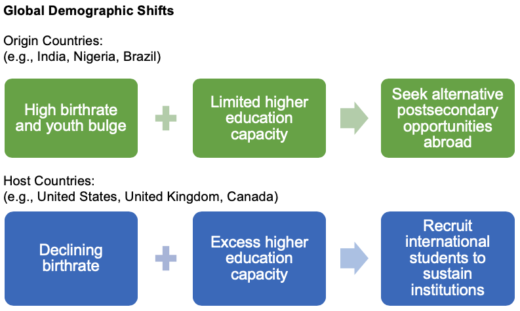International student enrollment grows modestly in Massachusetts, declines across the rest of New England …
 The total number of enrolled international students at New England colleges and universities increased by 2.2% at all academic levels in academic year (AY) 2018-19, according to the 2019 Open Doors Report on International Education Exchange. The study, published annually by Institute of International Education (IIE) since 1948-49, and in partnership with the U.S. Department of State’s Bureau of Educational and Cultural Affairs since 1972, reports on the number of international students enrolled at U.S. higher education institutions.
The total number of enrolled international students at New England colleges and universities increased by 2.2% at all academic levels in academic year (AY) 2018-19, according to the 2019 Open Doors Report on International Education Exchange. The study, published annually by Institute of International Education (IIE) since 1948-49, and in partnership with the U.S. Department of State’s Bureau of Educational and Cultural Affairs since 1972, reports on the number of international students enrolled at U.S. higher education institutions.
First, the good news from the Open Doors data. The U.S. remains the top destination for foreign students pursuing a postsecondary education abroad–a position it has maintained for over a century. The total number of foreign students in the U.S. increased 0.05% in AY 2018-19, and the nation’s postsecondary institutions hosted twice as many international students as the next two hosts–the United Kingdom and China–combined. International students now account for 5.5% of total higher education enrollment across the U.S.
The rise in international student enrollment in the U.S. is consistent with a global trend in foreign enrollment growth among the world’s top hosting countries, which include the United Kingdom, Canada, Australia and China.
While we often talk about the demographic changes affecting higher education enrollment in New England, a panelist at the Open Doors 2019 Annual Data Release event on Nov. 18, suggested that two global demographic trends are converging to drive international enrollment patterns. The top countries of origin (e.g., India, Nigeria, Brazil) have high birth rates and are experiencing an explosion in the growth of the youth population. At the same time, these countries have a limited higher education capacity, which has caused their population to seek postsecondary opportunities abroad. By contrast, the top host countries worldwide (e.g., the U.S., United Kingdom, Canada) have declining birth rates and excessive higher education capacity. Consequently, these countries have recruited aggressively from foreign nations to sustain their institutions and attract global talent.

Source: 2019 Open Doors Report presentation.
Yet, despite the overall positive growth in international student enrollment across the U.S., the figures are mixed across New England. The report shows:
In 2019, Massachusetts was the only New England state to see growth in foreign student enrollment compared with 2018 (+4.3%). Until last year, the number of international students had increased in every New England state annually since 2012. As the chart below shows, this trend was reversed in five of the region’s six states, with Vermont having the sharpest decline (-9.5%).
| State | Number of International Students | % Change from 2018 | Rank in the U.S.* |
| Connecticut | 14,832 | -2.9 | 20th |
| Maine | 1,335 | -0.6 | 49th |
| Massachusetts | 71,098 | +4.3 | 4th |
| New Hampshire | 4,333 | -1.3 | 38th |
| Rhode Island | 5,376 | -1.9 | 37th |
| Vermont | 1,692 | -9.5 | 47th |
| Source: NEBHE analysis of data from the 2019 Open Doors Report.
*Rankings include all 50 U.S. states, in addition to Washington, D.C., Puerto Rico and the U.S. Virgin Islands. |
|||
Despite declining enrollment in most New England states, three states have a share of international students that is at least 5.5% higher than the national average: Massachusetts, Connecticut and Rhode Island. The concentration of foreign students in Maine, New Hampshire, and Vermont is below the national average.
Massachusetts is one of only six U.S. states to host more than 50,000 international students. Nationally, roughly one-third of all foreign students enrolled in U.S. colleges are in California, Texas and New York.
Despite concerns in academic admissions offices about China’s deepening economic downturn and the effects of the retaliatory tariffs enacted by President Trump, China remains the largest source of foreign students in the New England. In 2018-19, 34% of foreign students enrolled in undergraduate, graduate, non-degree, and optional practical training (OPT) programs across the region originated from China. Over the same period, 369,548 Chinese students enrolled at universities across the U.S., which also accounted for 34% of the foreign student population. Enrollment of Chinese students at American institutions was up 2% in AY 2018-19. The second highest share of foreign students in the U.S. originated from India and the third highest, from South Korea. Of all foreign students in the U.S., 52% originated from China and India alone.
Enrollment from Nepal and Vietnam has been rising over the years, and those countries are now represented among the top five places of origin in New England. The growth in the Nepalese and Vietnamese student population in the U.S. is primarily a factor of continued support from their governments in the form of scholarships to students. Also of note, Vietnam is now the second largest country of origin for all foreign students at U.S. community colleges.
International students are major contributors to New England’s economy. In AY 2018-19, international students contributed $45 billion to the overall U.S. economy, with $4.3 billion added to the New England economy alone, according to NAFSA: Association of International Educators. Between 2012 and 2019, international students contributed a total of $6 billion to the New England economy, based on NASFA’s calculation of tuition and fees, room and board charges and other living costs.
International students are vital to the nation’s domestic vitality and global relations. Domestically, foreign students contribute to the U.S. economy. Internationally, these students help open new chapters in U.S. relations with foreign countries, often enabling us to build beneficial and diverse relationships abroad. In our analysis of the 2018 Open Doors Report, we warned that New England’s strong international enrollment figures may be in jeopardy. The negative foreign enrollment growth shown in the 2019 data in all but Massachusetts suggests that our predictions may be coming to pass. Given the concerning dip in the region’s overall higher education enrollment due, in large part, to declines in domestic birth and high school graduation rates that are both projected to continue through 2032, a continued drop-off in international students could add an additional pressure point that might cause serious pain beyond academia.
Stephanie M. Murphy is a policy & research analyst at NEBHE.
[ssba]
